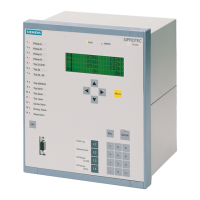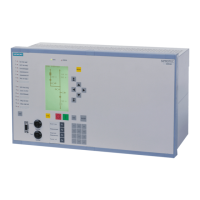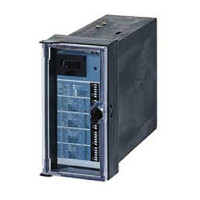Unbalanced Load Protection
Unbalanced load protection (negative sequence protection) detects unbalanced loads on the system. In addi-
tion, this protection function may be used to detect interruptions, faults, and polarity problems with current
transformers. Furthermore, it is useful in detecting phase-to-earth, phase-to-phase, and double phase-to-earth
faults with magnitudes lower than the maximum load current.
The tripping circuit monitoring is only sensible in three-phase protected objects. Whereas PROT. OBJECT =
1ph Busbar or 1 phase transf. (see Functional Scope, address 105, Section 2.1.3.1 Setting Notes) the
following settings are not available.
In case of generators and motors, unbalanced loads create counter-rotating fields which act on the rotor at
double frequency. Eddy currents are induced at the rotor surface leading to local overheating in rotor end
zones and slot wedges.
In case of motors with fuses connected in series, a motor operating in single-phase condition due to operation
of a fuse, only generates small and pulsing torque so that it is soon thermally strained assuming that the
torque required by the machine remains unchanged. In addition, with unbalanced supply voltage it is endan-
gered by thermal overload. Due to the small negative sequence reaction even small voltage asymmetries lead
to negative sequence currents.
The negative sequence protection always refers to the three phase currents of the configured side or meas-
uring location (see Section 2.1.4.3 Assignment of Protection Functions to Measuring Locations / Sides).
The unbalanced load protection consists of two definite time stages and one inverse time stage, The latter
may operate according to an IEC or an ANSI characteristic. A stage with a power-proportional characteristic
(negative sequence current) is possible instead of the inverse time stage.
Functional Description
Determination of Unbalanced Load
The unbalanced load protection of 7UT6x filters fundamental components from applied the phase currents
and dissects them into their symmetrical components. Of this the negative sequence current of the system Ι
2
is evaluated. If the largest of the three phase currents lies above the minimum current PoleOpenCurr. of
the one assigned side or measuring location and all phase currents are smaller than 4 times the rated current
of the assigned side or measuring location, then the comparison of negative sequence current and setting
value can take place.
Definite Time Stages
The definite time characteristic is of two-stage design. When the negative sequence current exceeds the set
threshold I2> the timer T I2> is started and a corresponding pickup message is output. When the negative
sequence current exceeds the set threshold I2>> of the high-set stage the timer T I2>> is started and a
corresponding pickup message is output.
When a delay time is expired trip command is issued.
2.8
2.8.1
Functions
2.8 Unbalanced Load Protection
SIPROTEC 4, 7UT6x, Manual 187
C53000-G1176-C230-5, Edition 09.2016

